Varicose veins are a specter of modern humanity. But often the treatment of varicose veins, an individually chosen scheme, ends successfully. Sometimes the only problem is therapy and medications, but sometimes the condition can only be cured with surgery. What is the way to get rid of this unpleasant and serious disease?
Varicose veins - basic information
Varicose veins are a pathological condition characterized by damage to the venous tract.
There is a special valve in the vein, which serves as a kind of closure, preventing blood from flowing down (venous blood in the legs flows from the bottom up).
Valve system failure causes blood reflux and congestion.As a result of this process, the veins are weak, stretched and deformed, unable to cope with the increased blood pressure.
The result is a common symptom of many people - blood vessels that bulge on the surface of the skin, indicating the development of dynamic pathology.
All the scams of this disease lie in the fact that at an early stage it manifests itself as fatigue and a feeling of heaviness in the legs.
So many are in no hurry to see a doctor, and they start sounding the alarm when blue strands appear on the skin, ruining the appearance of the feet.
Learn more about the symptoms of early varicose veins here.
The reasons for the development of this pathology are very diverse.These include congenital abnormalities of the vascular system and several provoking factors: unsteady lifestyle, overweight, uncomfortable shoes, professional activities associated with long standing.
Treatment of the disease is always done thoroughly.The required scheme is chosen by the specialist based on the stage of disease development and the individual characteristics of the organism.
Which doctor treats veins?
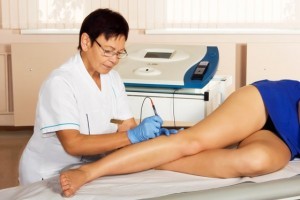
Varicose veins are not only dilated veins, but also serious valve dysfunction and failure in blood circulation, leading to severe complications throughout the body. And if the first symptoms appear - swelling of the veins, muscle spasms, constant weight in the legs - you should immediately make an appointment with a phlebologist.
Based on the severity of the case, the cause of the disease and its state of health, the doctor will select the most appropriate course of treatment from the current options.
Threatening Symptoms
The main causes of varicose veins are: heredity, overweight, inactive lifestyle, inactive or standing work, hormonal imbalances in the body. According to statistics, 40% of adult women and 20% of men have signs of varicose veins.
A phlebologist is involved in the diagnosis of the disease, you should contact himif the symptoms appear:
- Difficulty in the legs getting worse by the end of the day.
- Rapid leg fatigue during long walks.
- Pain in the legs.
- Appearance of fine vascular tissue in the foot.
- Swelling of the feet.
- Cramps that increase in intensity at night.
- Itching on the skin at the bottom of the feet.
atrophy of superficial vein muscle fibersgradually develops, blood vessels lengthen, expand, become winding, knots appear on them protruding above the surface of the skin. The skin on the enlarged veins becomes bluish red, dry and hot, boils appear due to lack of tissue.
Due to dystrophic changes in the subcutaneous fat layer, lipodermatosclerosis can develop - a dangerous complication of varicose veins in the legs, whose treatment with conservative methods may not be successful.
To avoid the consequences of severe varicose veins, phlebologists advise their patientsto begin treatment in a timely mannerwhen the first signs of the disease appear.
Methods of treatment
Sclerosis is very effective, consisting of injecting a special sclerosant material into the vessel using a syringe with the best needle. The venous lumen is tightened, the ruptured edges are soldered, thus stopping the secretion of blood outside the ducts. The material itself, after fulfilling its function, is absorbed.
This method removes all blemishes and gives excellent cosmetic results. But after the procedure, it is necessary to take care of the condition of the veins with additional therapy and wear compression clothes.
Nearly 10 years ago, lasers, more precise endoven laser freezing, began to be used successfully in medicine to combat varicose veins. Treat the vein as follows:
- Using local anesthesia, a small puncture is made in the vein.
- Optical fiber is inserted into the resulting hole.
- The laser acts on the damaged area, covering the damage.
- Then a new cloth appears in the closed place.
The operation is not performed "blindly" - the process is monitored through an ultrasound machine, so there is practically no risk of failure. Moreover, the absence of significant incisions does not include painful sensations, the formation of bleeding, and violations of nearby tissues.
After the procedure, you should wrap the affected part or wear stockings and compression stockings.
Radio frequency ablation is often used, and high frequency currents successfully treat varicose veins. It happens as follows:
- The vein is pricked.
- The catheter is inserted into the hole.
- Rays enter the ship through it.
- Conductors act at the molecular level, altering protein molecules in damaged veins.
This method allows you to treat all varicose veins quickly, and no special postoperative therapy is required.
Methods for treating varicose veins
There are two of them: conservative and surgical. Patients are faced with an urgent question: how to treat varicose veins on the legs without surgery. When choosing a method, the doctor takes into account the symptoms, the stage of the disease, the presence of complications, concomitant diseases, the age of the patient. Non-surgical methods to remove varicose veins in the lower part of the leg give good results only when the pathological symptoms are still poorly expressed.
To stop degradation of affected vessels, help:
- drug therapy;
- compression treatment;
- physiotherapy training;
- physiotherapy;
- urut;
- traditional medicine recipes;
- diet.
Phlebologists try to select patients during pregnancy exclusively non-drug methods to treat varicose veins in the lower legs. First of all, these are clothes in compression, gymnastic exercises, physiotherapy, massage, diet. If medication is still needed, only medication for external use is prescribed.
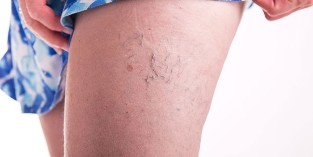
The debate continues over whether hirudotherapy helps with varicose veins. Hirudin produced by leeches, penetrates into the venous system at the bottom of the foot, diluting thickened blood. However, today there are many modern medicines with similar properties. In addition, there are risk factors for the use of leeches - vascular infections, allergic reactions.
If necessary, treatment of varicose veins is done using radical methods. This:
- sclerotherapy;
- ozone therapy;
- cryotherapy;
- electrocoagulation;
- laser freezing;
- surgical intervention.
Sclerotherapy - an injection into a sore vein of a drug that "attaches" to the widening ducts. It stops pumping blood and gradually dissolves. The maximum effectiveness of sclerotherapy is achieved in the early stages of pathology. A similar method is ozone therapy: part of this gas is injected with a syringe into the lumen of a small vein, and the vessel is also "united".
Cold is used during cryotherapy procedures. During electrocoagulation, high frequency current is supplied to the vessel through a very thin electrode. Laser treatment of varicose veins is also an effective modern method, especially when used in conjunction with conservative methods. At the same time, the cosmetic yield is high: after a few weeks, the patient does not experience scars or scars.
However, surgical removal is the most effective treatment that allows you to get rid of varicose veins radically when drug therapy does not lead to the desired results. The diseased vessel is removed through a local subcutaneous incision. After surgery, the legs are tightly wrapped, and after three to four hours the patient is able to walk.
Principles of medical treatment of varicose veins
Effective treatment of varicose veins is possible only if the selected drug inhibits the mechanism of pathological development, destruction of walls and vascular valves.
The main tasks of varicose vein drug treatment are:

- circulatory recovery;
- venous wall strengthening;
- increased vascular tone;
- lowers blood viscosity;
- prevention of blood clots;
- normalization of valve system;
- elimination of inflammatory processes;
- normalization of blood circulation in capillaries.
Medication is essential in the treatment of complex diseases.
They are also widely used for preventive purposes, which is very important for people at risk of pathology.
To date, there are a large number of drugs for the treatment of varicose veins in the legs and they all differ in composition and mechanism of action.
See a doctor
Varicose veins are a serious disease, which, if treated incorrectly or not, can threaten various complications that are dangerous to human health and life.
Help. Vital vein thromboembolism, thrombophlebitis, trophic ulcers - this is not a complete list of varicose vein complications that pose a threat to humans.
Accordingly, you should also not try to cure yourself.
Experiments at home with drug selection can make the situation worse or ineffective.
In any case, this is a waste of time, health and funds.Therefore, you should contact a phlebologist. Only a specialist can choose the right medication and build a treatment regimen to get the maximum benefit for the patient.
What drugs are used
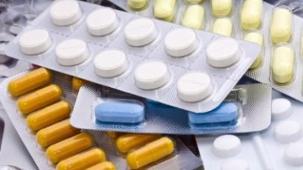
Complex treatment of varicose veins consists of the use of several groups of drugs at once:
- Phlebotonics.
- Anticoagulant.
- Anti-inflammatory.
- Fibrinolithic.
Also, to enhance the therapeutic effect,systemic and local influence methods are used.
Creams, gels, ointmentsare used as topical preparations. When choosing a preparation for varicose veins and thrombophlebitis, keep in mind that it is an agentin the form of an ointment characterized by the highest active ingredient content.
Important!A common contraindication to all local remedies is a violation of skin integrity.
As a rule, such drugs are used several times a day, and the product should be rubbed with light movements from the bottom up.
Group of drugs and their effects
In the case of varicose veins, drugs are classified according to the type of action inthree main groups:
- venotonic or phlebotropic drugs;
- blood-thinning agents (anticoagulants) and drugs that inhibit platelet adhesion (antiplatelet agents);
- Anti-inflammatory drugs.
Medical research and practice have proven the effectiveness of phlebotonics developed based on natural flavonoids- diosmin and hesperide. These substances not only protect vein cells, but stimulate lymph outflow and stabilize capillary function. Simultaneous administration of combination drugs in which both flavonoids are present is highly effective.
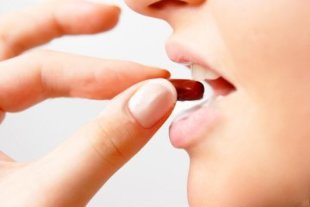
Usually phlebotropic agentsare taken from 2 to 3 months in the course. It is important that the reception coincides with the summer, when the load on the ship increases due to the high air temperature and the large volume of water consumption. If varicose veins are accompanied by chronic venous insufficiency, phlebotonics is always taken in half the dose.
A patient with a diagnosis of varicose veinsshould receive systematic treatment from the beginningto prevent disease progression and reduce the likelihood of complications.
The second task is completed with drugs that thin the blood (anticoagulants) and improve their circulating properties, preventing the formation of thrombotic clots (antiplatelet agents).
The formation of blood clots, their separation from the vascular wall and movement along the venous bed causes the overlap of the human heart, lungs and brain. As a result, the risk of heart attack, pulmonary embolism and ischemic stroke is very high.
Antiagretat is not a cure for varicose veins, but is used as a tool to prevent serious complications- thrombosis and thrombophlebitis. We can say that these drugs save the lives of patients and reduce the threat of disability to a minimum.
Operation
Removal of a damaged vein in the lower leg or part is done through an incision or puncture. Removal of diseased vessels in the clinic is necessary if:
- veins in the legs grow pathologically;
- affected skin;
- trophic ulcers appear;
- thromboflebitis is getting worse.
Surgical treatment of varicose veins on the legs is contraindicated:
- for severe hypertension, coronary artery disease, infectious diseases, eczema;
- if the patient has reached old age;
- during pregnancy (more than 5 months).
Complementary therapy
In addition to medical and surgical treatment, additional therapy is very important, including a number of steps to restore normal veins:
- The bandage has a relaxing effect, removing the feeling of heaviness in the legs. When buying the necessary funds, keep in mind that hot wraps for varicose veins are contraindicated.
- Foot baths are another way to relieve foot pressure. By using medicinal ingredients and oils, you can strengthen blood vessels, eliminate swelling and redness. But the effect will only occur with the use of daily methods.
- Contrast showers. 10 seconds cold watering and 30 seconds warm (hot water is best avoided) for 5-7 minutes every morning will help keep your veins in good condition. For this purpose, you can use Alekseev or Charcot showers.
Phlebologists often include physiotherapy in complex treatments - laser, magnetotherapy, electrophoresis.
They do not cause discomfort and pain, are cheap and quite effective. In addition, treatment is performed under the supervision of a medical professional. The main condition is regular visits to the office.
Physiotherapy has a beneficial effect on the condition of venous walls, muscle tissue and valve activity.
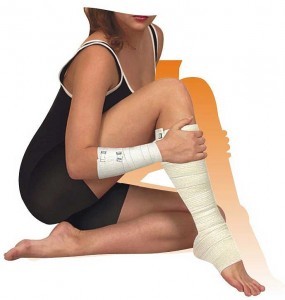
Compression therapy is an important component of not only treatment, but also prevention and postoperative periods. The use of bandages will prevent stagnant processes, support damaged ducts, and stop the progression of the disease.
Wearing a bandage requires little knowledge and agility, as excessive withdrawal can cause deterioration, and a weak bandage will not give the desired effect. Therefore, for proper use of the bandage, it is necessary to see a doctor.
Massage for varicose veins is not acceptable in all cases, so only a doctor can tell whether it should be used in a particular case or not. If the method is chosen correctly, then after the first session you can feel the results. This method can cause an increase in blood microcirculation, relieving the main symptoms of the disease, including external ones.
The more advanced the disease, the harder it is to fight it, and sometimes the patient comes too late, and there is only one way out - phlebectomy. To prevent this from happening, one cannot wait for complications, but get timely help.
Conservative methods
Phlebologists in the treatment of varicose veins strive to perform without unnecessary traumatic surgery in the early stages of the disease. For example, this is typical for reticular varicose veins, a manifestation of which is limited to the network of blue veins. The drug helps to improve the condition of the valves and walls of the vessel. Men, like women, should wear compression socks. Pathology cannot be completely cured. However, conservative methods stop the development of varicose veins and protect against complications.
Gymnastics

Exercise therapists know how to get rid of leg veins by doing physiotherapy exercises. This is possible provided that the exercise, which increases blood flow in the legs, is done systematically. For example:
- In a standing position, the heel of the foot is raised alternately.
- In the same standing position, they slowly rise on their toes and just as they slowly descend.
- Sit on a chair, roll a small ball on the floor with your feet back and forth.
Wear special underwear
Doctors recommend combining medical treatment of varicose veins with wearing compression pants - these are products made from a special type of knitwear that puts pressure (compression) on the veins. The level of linen pressure on the vessel wall can be adjusted by purchasing products with different levels of compression.
There are four degrees of compression overall: the first is used for prevention, the rest for treatment. With varicose veins on the bottom of the legs, tights, stockings, knee-high and leggings worn, the doctor chooses the required level of compression.
Compression panties produce a solid crushing frame on the feet, thanks to this, the following effects develop:
- Weak leg muscles are supported.
- The walls of blood vessels are compressed, preventing them from stretching.
- Lymph flow and blood circulation are stimulated.
- Stagnation is eliminated.
- Venous valve function is normalized.
- The load on the dilated vein is reduced.
- Thrombophlebitis is prevented.
It is mandatory to wear compression socks after surgery for varicose veins. Underwear helps prevent the recurrence of the disease, providing additional support to the body during the recovery period.
Compression sclerotherapy
Compression sclerotherapy is a modern method of treating varicose veins, which consists of injection of the drug into the affected vein. As a result, sclerosing (gluing) of the venous wall occurs, blood flow at the injection site stops, and the veins gradually dissolve or leave almost invisible strands that do not bother the patient at all.
Sclerotherapy is usually performed when the spider veins appear, when the varicose veins are in the early stages. With the progressive development of varicose veins, treatment with sclerotherapy is performed after analyzing the condition of the venous valve and vascular wall, a functional feature of the patient's circulatory system.
If a decision is made to perform compression sclerotherapy, the patient undergoes a blood clot test and ultrasound examination of the vein. During sclerotherapy, the patient does not experience a painful sensation, as the drug is injected into a vein using the thinnest needle. After the end of the procedure, a sterile bandage is applied to the medication area, the patient wears compression clothing. The first week after sclerotherapy, compression socks must be worn at all times, then allowed to release at night.
Positive results of sclerotherapy:
- Effective blood flow restoration.
- Exception of blood clots in damaged veins.
- Prevention of trophic disorders in tissues.
- Elimination of clinical symptoms of varicose veins: edema, seizures, pain.
- Excellent cosmetic effect as the scattered veins disappear completely.
Diet
For more effective treatment of varicose veins in the legs, it is important to properly regulate nutrition. Berries, apples, citrus fruits, which contain flavonoids, antioxidants, rutin, help improve the condition of blood vessels. Thin blood provides adequate fluid intake daily (1. 5-2 liters). Diet with varicose veins on the legs is not suitable for fatty foods, fried, hot spices, alcohol.
People's solution
Treatment of varicose veins with folk remedies at home in the summer is very effective. The following recipe is popular:
- Feet 15-20 minutes compress with tomato paste. It has a high content of lycopene, which actively strengthens blood vessels and prevents blood clots. At the same time, it is useful to eat fresh tomatoes every day.
- Absorption of sweet clover, an indispensable ingredient for varicose veins: Art. l. the raw material is mixed with two glasses of boiling water, stored until cooled, filtered. They drink half a glass 3 times a day, the rest is used as a lotion.
What not to do
When diagnosed with varicose veins, you should pay attention to lifestyle, diet and exercise.Not allowed:
- active physical activity, running, jumping (yoga classes allowed);
- long standing or prolonged sitting position;
- use of all medications without consulting a phlebologist;
- long flight with foot position that does not move forcibly. In addition, at high altitudes, sharp thickening of the blood occurs, which leads to the formation of blood clots;
- take a hot shower, visit the sauna;
- Cupping and honey massages are strictly prohibited, only manual medical massage is allowed.
Possible complications
Trophic ulcersis a form of complication in varicose veins, which manifests itself in the development and deepening of long-term ulcers that do not heal. Typically, a separate painful ulcer appears in the lower part of the foot, where “exit” is often observed in the form of removal of serous hemorrhagic fluid covering the affected tissue.
Immediate medical attention
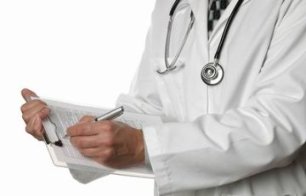
Immediate medical attention is required if any of the following symptoms occur:
- Increased pain in the affected limb, inability to wake up or take some steps;
- The skin on the feet feels hot, swollen and firm when touched.
- Skin color changes from pale to bluish or bluish red;
- Sudden shortness of breath, shortness of breath, sweating and severe weakness;
- Bleeding from affected skin or varicose veins.
Medications needed for varicose veins in the lower part of the leg must be included in a complex treatment regimen.Even after surgery, several courses of phlebotonic and antiplatelet drugs will be neededto prevent possible trophic disorders, inflammation and complications associated with the disease.
Many multicomponent drugs for varicose veins act in combination, having several functions. The effectiveness of such drugs is more pronounced.It is optimal to use a course of treatment in the correct dosage, calculated by a phlebologist, in combination with compression therapy, yoga classes, swimming in the pool, herbal medicine.
Conclusion
Complex treatment of varicose veins on the lower leg involves the use of various therapeutic techniques.
Along with medication, physiotherapy, special exercises, massage, and more.




































